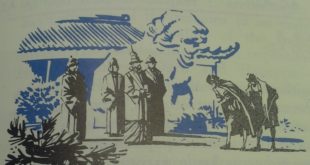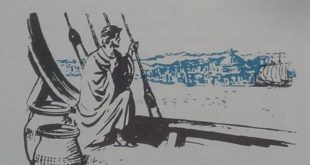Thirteen and a half centuries ago a new religion began in Arabia. Today millions of people are followers of this religion. It is called Islam and its followers, Moslems.
All their lives long, Moslems must pray, in ways clearly prescribed, five times every day. No ordinary event must be allowed to interfere with these moments of prayer. Moslems must learn to recite their creed — a long statement of their religious belief. For one month each year they must fast all of every day from sunrise to sunset. They must give generously to charity. They should, if at all possible, go at least once during their lives to the holy city of Mecca, where Mohammed, the founder of Islam, began this new religion.
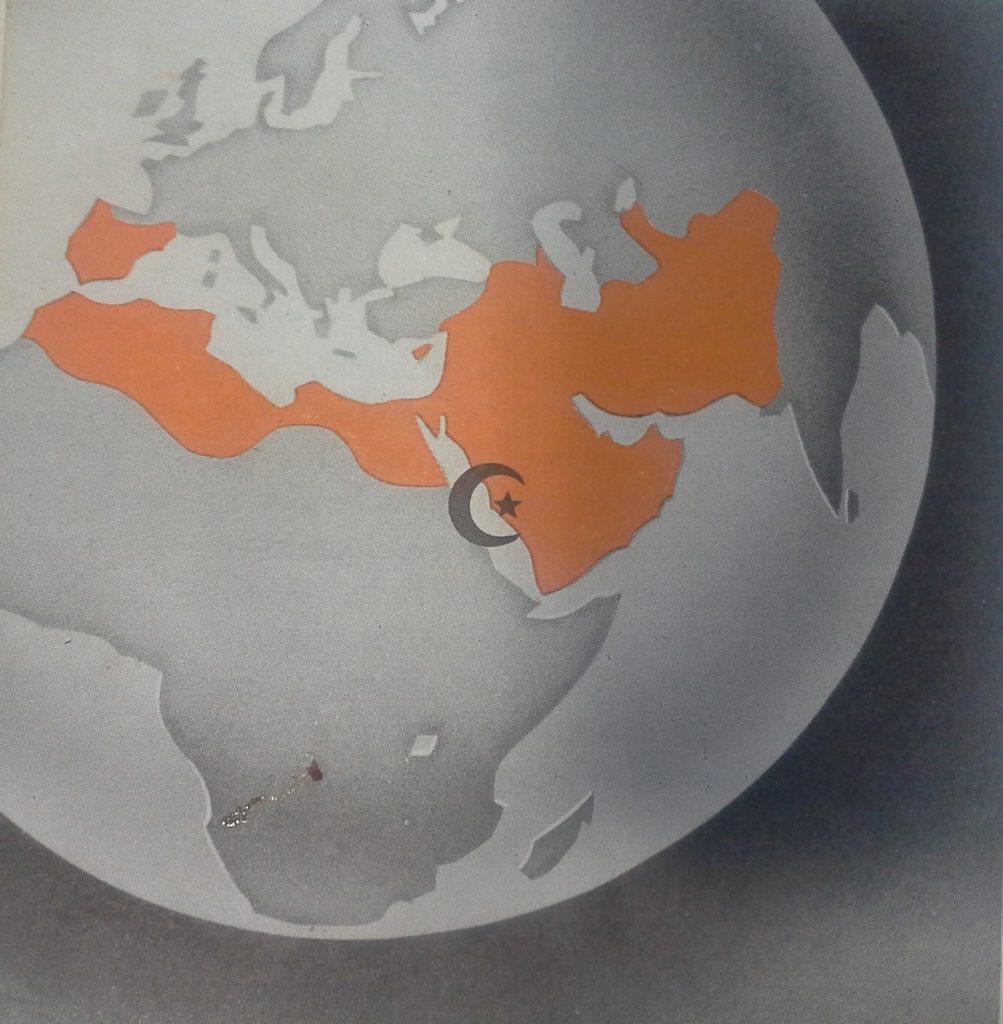
People of other faiths are forbidden to enter Mecca. A few miles outside of Mecca, Moslems must change to pilgrims’ dress and proceed barefoot when they enter this city, high up in west-central Arabia.
Mohammed and his first followers were Arabs. Arab merchants and Arab warriors, influenced the history of other peoples. United by loyalty to their religious faith, Arabs created a large empire. Arab rulers occupied positions of great influence and were keenly interested in advancing learning. How did all this come about?
1. How did the religion of Mohammed create a powerful Moslem world?
2. What kind of civilization developed in the Moslem world?

1. How did the Religion of Mohammed Create a Powerful Moslem World?
Arab civilization started later than other great civilizations. The story of the Moslem world began about 600 A.D. in Arabia, a huge peninsula covered for the most part with burning desert. Arabia is separated from Africa by the Red Sea and from Iran (Persia) by the Persian Gulf. To the north and west of the Arabian peninsula is the Fertile Crescent, where Sumerians. Babylonians, Assyrians, Phoenicians and Hebrews had developed their civilizations centuries before. People had inhabited Arabia, too, for hundreds of years, but had lived a simple kind of existence. Along the caravan routes which crossed the desert and in the spice-growing area at the entrance to the Red Sea there were trading and farming settlements. These towns and villages had reached a fair level of prosperity and civilization. Most of the Arabs were wandering herdsmen. They lived in tents and followed their herds of goats, sheep and camels from water hole to water hole, the sandy wastes of the Arabian desert.
The Arabs were not a united nation, but were divided into a number of tribes that were constantly warring with one another. They were, however, loosely bound together by ties of common customs, language and religion. Their language resembled that of the ancient Hebrews and Phoenicians, but they had little or no literature or art. Their religion was simple and consisted largely of worshiping spirits which they believed inhabited trees and stones. In the towns men also built shrines in which they placed stone idols to represent some of their gods. The Arabs had a special reverence for a certain black stone in the caravan city of Mecca. So sacred was this stone that it was kept in a shrine called the Kaaba, which stands to this day. Yet the religion of the Arabs also contained hints of ideas like those of the early Hebrew faith. Undoubtedly these ideas were passed along by traveling merchants who traded with Hebrew and Christian peoples in the Near East.
Mohammed founded a new religion. Into such a world was born in the city of Mecca about 571 A.D. one of the great figures of history, Mohammed. An orphan who grew up amid poverty and hardship, Mohammed served as a camel herder. Finally he became a well-to-do and respected caravan leader. He was a lean, well-built man of medium height with the small hands and feet typical of the Arabs. His eyes were large and black, the colour of his long wavy hair. His strong, white teeth flashed with his frequent smile which won him many friends.
In his long journeys across the desert, Mohammed had much time to think. He was a serious man and many of his thoughts had to do with religion. When he was 40 years old, Mohammed reached the decision that he had been chosen to be God’s messenger or, prophet to his people. Mohammed called himself the Messenger of Allah. Allah is an Arabic expression meaning “The God.”
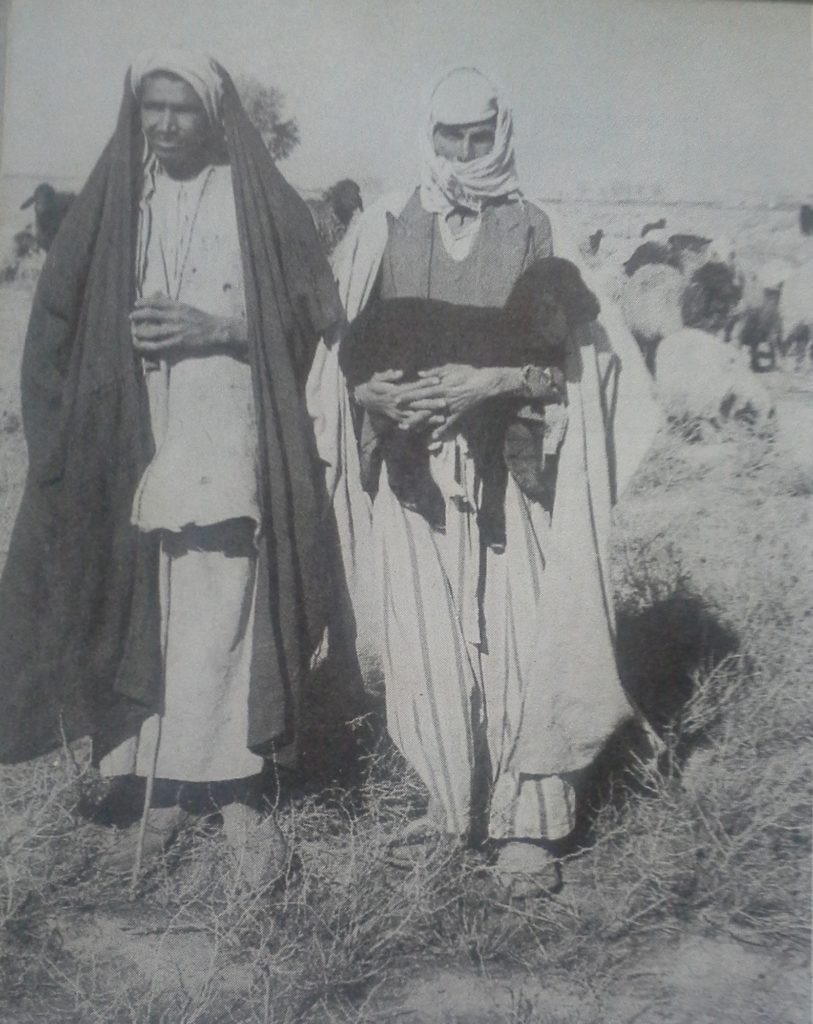
Mohammed’s teachings bore some resemblance to both the Hebrew and Christian religions. Moslems and Christians fought fierce wars for centuries, many people do not realize the close connection between Mohammed’s thinking on the one hand, Christianity and the ancient Jewish faith on the other. Actually, it is not strange that there should be a connection. Although they developed at different times, the three religions grew up in about the same region among very much the same kind of people. To Mohammed, the God of the Jews and the Christians was the same God as Allah. Mohammed believed, as did Christians and Jews, that the Old Testament prophets were true servants of God. “Abraham,” he taught, “was a model of true religion. obedient unto God and true in faith.” Mohammed also accepted Jesus as a major prophet of God — “Jesus the Son of Mary is the Apostle of God and His Word. . . .” But he did not believe that Jesus was divine. In fact, none of these earlier religious leaders (according to Mohammed) was able, as he was, to reveal God’s truth. Mohammed considered himself the last and greatest prophet. “There is one God, Allah, and Mohammed is His prophet.”
Mohammed preached against the evils practiced by his people and pointed out what he thought to be the true way of life. He attacked the Arab custom of worshipping idols. He condemned cruel treatment of animals as well as of human beings. He came out strongly against gambling, strong drink and the custom of killing unwanted girl infants. Honesty, kindness, the giving of help to the poor and needy, the saying of daily prayers were obligations which all true followers of Mohammed must practice. Mohammad also preached that after death there was a Day of Judgment, and that “the faithful” (meaning all good Moslems) would enjoy a never-ending existence of luxury and ease. Mohammed’s teachings were later collected and published in the Koran, the Mohammedan Bible.
Mohammed united the Arab people under his new religion. At first the Arabs did not take kindly to Mohammed’s teachings. He made many enemies, even in his home city of Mecca. So high did feeling rise against him that his very life was in danger. With his devoted wife and a few loyal followers, Mohammed fled secretly to Medina, a nearby city. The year of “The Flight,” or Hegira, was 622 A.D. Just as Christians use the date of Christ’s birth as the starting point of their calendar, so Moslems reckon all dates from the year of Mohammed’s flight.
Mohammed gathered together a small band of friends in Medina. When enemies from Mecca attacked, Mohammed was able to defeat them. He then returned to Mecca in triumph and destroyed the idols in the Kaaba. Mecca became the centre of Mohammed’s new faith. As you have learned, Mohammed called his religion Islam, meaning submission or surrender to the will of Allah. Its followers called themselves Moslems, though others sometimes call them Mohammedans.
After Mohammed’s return to Mecca, the new religion spread with great rapidity. All those who accepted Islam were united in a single Arab state governed by Moslem law. Mohammed himself was head of this state, although he declared himself neither king nor emperor. When he died in 632 A.D., his close followers chose a new leader called the Caliph, or “Successor.” The Caliph was both the religious and the political head of the Moslem state.
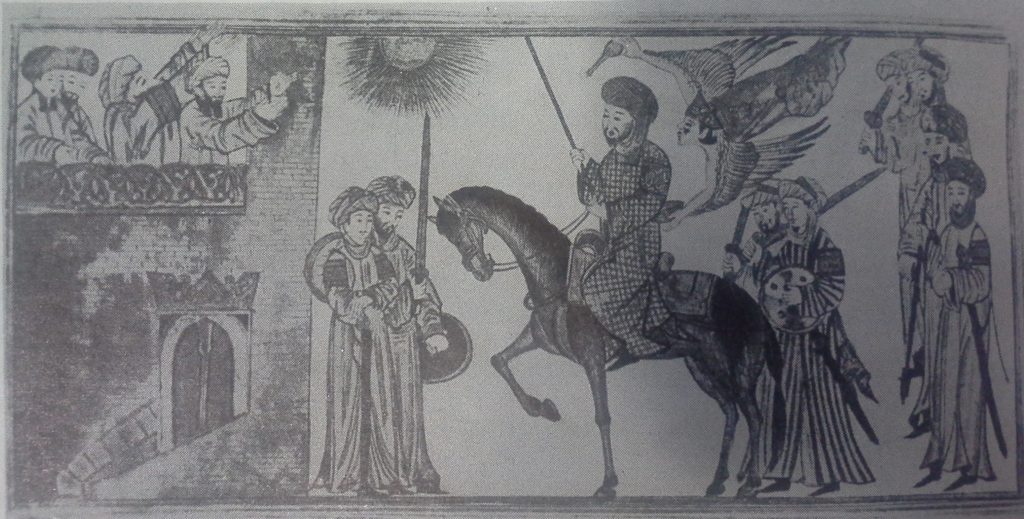
Mohammed, founder of Islam, is welcomed by his followers, in this old painting.
Following Mohammed’s death the Arabs expanded their power rapidly. Even in Mohammed’s lifetime there had been fighting between Arab Moslems and subjects of the Byzantine Empire. The Arabs were fierce fighters. Most of them were mounted on horses or camels and they moved with great speed. Arab attacks grew in number and strength. The Caliphs sent out these expeditions for two reasons: (1) to satisfy the desire of the restless Arab tribesmen under their control to fight and plunder; (2) to serve Allah. The religion preached by Mohammed was a warlike faith. What better way was there to serve Allah than to make war on those who refused to accept the true faith? If Allah willed it, even death in His service was welcomed. Such a belief made Moslem warriors almost unbeatable.
The Arabs found the neighbouring Byzantine and Persian Empires weakened by long wars. Moreover, many of the people who lived in the eastern part of the Byzantine Empire hated their government. Far from resisting the Arabs, these subject peoples welcomed them. So within a few years the Caliphs’ armies overran Syria, Egypt, Mesopotamia and Persia.
The Arabs ruled their subjects wisely. The Arabs came to conquer and plunder, but they stayed to rule. In 661 A.D., their capital was moved from Arabia to Damascus in Syria. There the Caliph had his court and governors were selected to rule the conquered countries. The Arabs of this period treated their subjects well. Landholders were allowed to keep their lands, but they had to pay a tax on them. Though all non-Moslems had to pay a special tax, they were permitted to worship as they wished.
The Moslem Empire expanded to the West. The warlike followers of Mohammed pushed into new lands with incredible speed. They advanced westward along the North African coast until they reached the Atlantic Ocean. In what is now Algeria and Morocco they converted the fierce Berber tribes to Islam. Then Berbers and Arabs crossed the Strait of Gibraltar into Spain and overthrew the kingdom which the Goths had set up there. Almost the whole of the Spanish peninsula fell into the hands of these Moslem conquerors. Moslem raiding expeditions also crossed the Pyrenees Mountains and conquered territory in what is now southern France. In 732 A.D., exactly 100 years after the death of Mohammed, the Moslem threat to western Europe ended. The Moslem invaders were turned back in a battle near Tours by the Franks.
The Moslems from the deserts of Arabia were not by nature seamen. When they conquered harbour towns along the Mediterranean coast, they made use of their seafaring subjects and converts. Soon Moslem fleets began to attack the islands and northern shores of the Mediterranean and to prey upon the shipping of Christian nations. The southern shore of the Mediterranean along which these pirates lurked was known as the Barbary coast. (Barbary means “of the Berbers.”) The Barbary pirates continued their raids until the early 1800’s. In American history, the citizens in the early 1800’s refused to pay tribute to these Barbary pirates and the young American navy had a hand in stopping this evil practice.
Moslem power swept eastward as well. The Moslem armies also pushed their way across central Asia and into the Indus valley in India. They plundered Asia Minor and reached the Sea of Marmara, but the Moslems failed to capture Constantinople and overrun Europe from the east. On two separate occasions the armies and fleets of the Caliphs blockaded Constantinople, but both times they were forced back with great losses. Not until several centuries later (1453) did Christian Constantinople fall before the onslaughts of the Moslems. At that time the victory was won by Moslem Turks rather than by Arabs.
The world of Islam broke into a number of independent states. In little more than a century, then, the successors of Mohammed built up a huge empire extending from Spain to India. Yet the very size of this empire made it difficult for a single ruler to control it. In time, able and ambitious governors staged successful revolts and set up independent states under their own rule. A rebellion in Persia led to a new line of caliphs who moved their capital from Damascus to Baghdad. A rival line of caliphs was set up in Spain with Cordova as the capital city. A third caliphate arose in Egypt, where the city of Cairo was founded as the residence for the new rulers. Other Moslem states were formed by less important rulers.
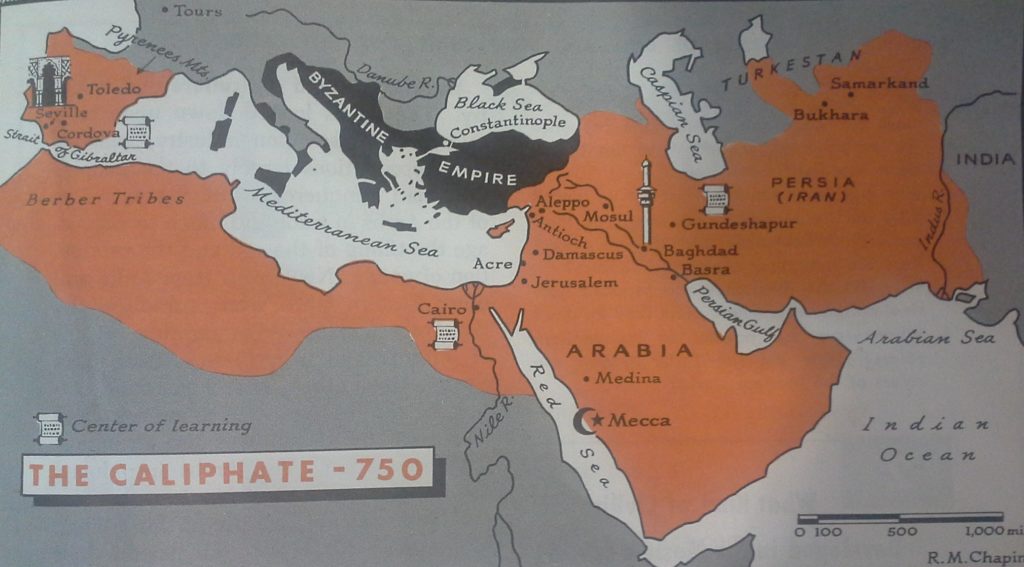
This division into smaller units put an end to the expansion of the huge Moslem Empire. Quarrels among leaders did not stop the spread of the religion of Islam. Traders and missionaries carried this faith across Asia. Others worked their way up the Nile valley into central Africa. Still others traveled southward along the eastern coast of the African continent. All carried with them the message of Mohammed — faith in Allah.
Moslem rule was autocratic. In the Arab states the rulers, both the caliphs and those who took other titles, possessed complete control over all their subjects, both Moslems and non-Moslems. Their will was supreme. This form of government worked well enough when the rulers were good men of strong character, but evil men tended to abuse their power and to oppress their subjects. Many of the Arab rulers were immensely wealthy. They built magnificent palaces and lived amid great luxury. Oftentimes they were more concerned with pleasures than with the affairs of government. When Arab rulers were weak or lazy, they frequently left the work of government to their viziers, or chief ministers. It was possible for a vizier to become so powerful that he could appoint or dismiss high officials and have a member of his own family succeed him in office. In some cases the palace guards made a ruler virtually a prisoner and took over control of the government.
Turks later dominated the Moslem world. Conditions like these finally led to the downfall of the Caliphates of Cordova, Egypt and Baghdad. After about 1050 a people from central Asia, the Seljuk Turks, became the most powerful force in the Moslem world. The Seljuk Turks had accepted the religion of Mohammed and excelled as fighters. They worked their way into the city of Baghdad and took over the power or the Caliph, though he remained the religious leader of his people. The authority of government, however, passed into the hands of the Turkish chief, better known as the Sultan. In the 1200’s still another people from central Asia, the Ottoman Turks, became the leaders of the Moslem world.
In brief, the leadership of the Moslem Empire shifted from the Arabs to the Turks in later centuries. It was under the early successors of Mohammed that Moslem civilization actually took form. The Arabs not only developed their own way of life, but achieved a high level of art and learning. To what they learned from subject peoples the Arabs added ideas of their own. Arabic civilization spread through the Moslem world and influenced peoples beyond its borders.
2. What kind of Civilization Developed in the Moslem World?
The Arabs were keen traders. For hundreds of years before Mohammed, the Arabs had been traders. They controlled the caravan routes across Arabia and along them they had built flourishing towns. Then came victories under the banner of Mohammed. As new lands were opened to trade, Arab merchants traveled freely — to Spain in the west and eastward as far as Turkestan, India and even China. Goods moved not only along land routes but over the sea. Moslem fleets had complete control of trade on the Red Sea and the Indian Ocean. They ventured southward along the east coast of Africa and eastward to the Spice Islands (which are now part of Indonesia) and even to the ports of China.
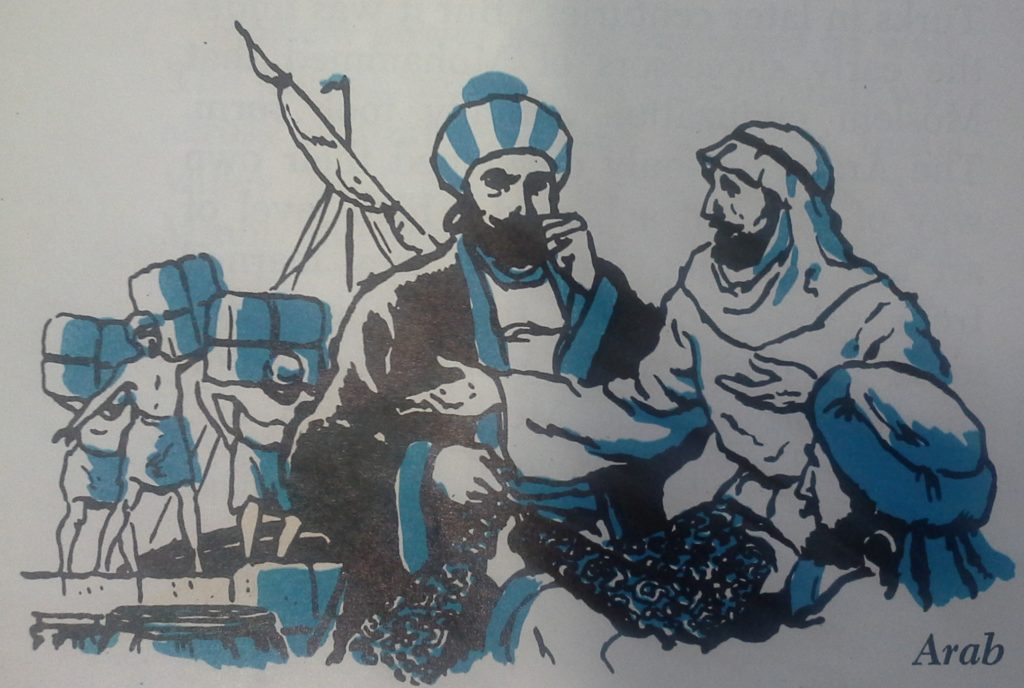
Trade stimulated agriculture and industry. The Arabs looked down upon crop raising and also upon industry and left these occupations largely to the peoples they had conquered, but the activities of the Arabs in trade did much to encourage the tilling of the soil and the production of goods. New crops from India and other Eastern lands were introduced by the Arabs into the great farming regions of Mesopotamia, northern Africa and Spain. Among these were sugar cane, cotton, rice and fruits such as oranges and lemons. Stock raising was also an important occupation. The Arabs introduced the camel as a beast of burden wherever conditions favoured the use of this animal and Arabian horses were famous for their speed and endurance.
In their thriving trade the Arabs had need for many goods. The towns of Syria, for example, had for a long time manufactured dyes, glassware and woolens. Under the Arabs they not only produced more of these goods, but also added the making of silk and cotton goods. Mesopotamia, Persia and Turkestan furnished textiles of fine quality, as well as rugs and tapestries. On their long journeys, Arab merchants carried the fine steel swords made in Damascus, Syria and in Toledo, Spain. Other popular metal articles in the Arab trade included lamps, trays and household objects of brass and bronze, inlaid with gold and silver. The Arabs also did much to encourage the manufacture and use of linen paper, which they had learned about from the Chinese. Paper could be produced in larger quantities and more cheaply than Egyptian papyrus.
The Moslem world had many important cities. Such bustling trade and industry encouraged the growth of large and wealthy cities. Some, like Toledo and Seville in Spain; Damascus, Acre and Aleppo in Syria; and Bukhara and Samarkand in Turkestan, were old towns which took on new life when Arab commerce began to thrive. Others, like Cairo in Egypt, Baghdad, Basra and Mosul in Mesopotamia, were new cities founded by the Moslems.
Of the many Moslem cities, Baghdad was easily the greatest and most imposing. With its huge and luxurious Caliph’s palace, its government buildings and its busy bazaars or groups of shops, Baghdad rivaled Constantinople in size, wealth and learning. All these cities had beautiful mosques or Moslem places of worship; magnificent government buildings and public baths; jostling throngs of workers, businessmen and travellers. The docks of seaport cities were crowded with goods of a hundred widely separated towns. A thousand years ago these thriving Moslem cities offered a sharp contrast to the small, unattractive towns of western Europe. Neither London nor Paris could compare with any one of a score of Moslem cities of that time. Of course there were many poor people in Moslem cities, but the upper and middle classes lived in a degree of comfort and cleanliness that was practically unknown in Europe.
Slaves were common in the Arab world. Like the Greeks and Romans, the Arabs used slaves. Mohammed did not try to abolish slavery, but he did what he could to better the treatment of slaves. Moslems regularly made slaves of non-Moslem prisoners of war. They also carried on a brisk trade with slave traders from Europe, Asia and Africa. Pirates scoured the seas and raided ports to obtain captives to sell in the slave markets.
Not all slaves received kind treatment. Those who were forced to pull the oars of the Arab galleys suffered great hardships, but some slaves rose to positions of power and trust. Former slaves even commanded Arab armies and became powerful government officials. Many caliphs and high officials were the sons of slave mothers.
For a time, Arab women enioyed considerable freedom. Before Mohammed’s time, women in Arabia had few rights and often were ill-treated. Mohammed did a great deal to improve their condition. Women were given fixed shares of the property of fathers or husbands who had died. Moreover, women had full control of their own property even when married. Although Mohammed did not do away with polygamy (the practice of having more than one wife), he forbade Moslems to have more wives than they could properly support. In no case were they allowed more than four.
Most Western people think of Moslem women as hidden away in harems and obliged to keep their faces veiled in public. Actually, for several centuries after Mohammed. Moslem women enjoyed a great deal of freedom. They moved about freely in social groups and worshipped in the mosques with the men. Gradually, however, there developed the custom of veiling women’s faces when in the presence of men and of keeping women shut up within their homes. No longer could they receive much education; no longer could they take part in the outside world. Their position was definitely lowered. In forward-looking Moslem countries today, however, restrictions on women’s freedom are again being removed. They are not only getting back their old freedom, but gaining new rights.
Throughout the Moslem world then was a remarkably uniform civilization. Although the Moslem world was divided into separate states and included many peoples, Moslem civilization was very much the same everywhere. There were at least three reasons for this uniformity: (1) All Moslems, of course, worshiped the same God (Allah) in the same way. (2) All Moslems followed the same rules of conduct, which came from the Koran. (3) Moslems generally used the Arabic language, even those converted from other religions. It is true that Persian and Turkish Moslems retained their native languages, but even for them Arabic was the language of religion. With such strong common ties, it was natural that the ideas and customs of all Moslems should be similar.
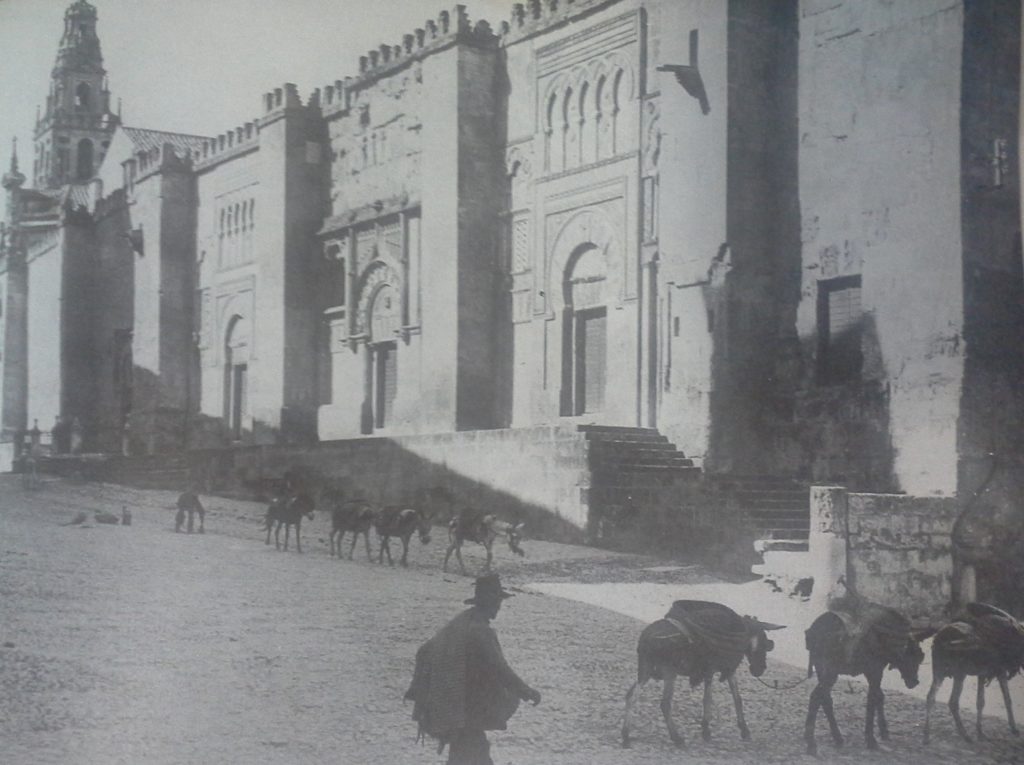
Moslem culture drew heavily upon earlier civilizations. At first, art and learning had meant little to the desert-bred Arabs, who scorned the more advanced ways of living followed by the people whom they conquered. Later, Arab leaders became interested in the arts, literature, and science. Moslem civilization then flowered quickly because it had a rich storehouse of knowledge within its grasp. Contacts with many countries, including the Byzantine Empire, brought Arabs in touch with what was left of Greek and Roman civilizations. Contacts with Asia made Arabs familiar with the accomplishments of Persian, Indian and even Chinese civilizations.
Arab rulers encouraged the growth of civilization in two ways. First, they permitted scholars to think and study freely. Ideas were not frowned upon merely because they came from strange people or foreign lands. The story is told of a famous Byzantine mathematician named Leo. So anxious was a certain caliph to have Leo visit his court at Baghdad that he offered the Byzantine emperor a permanent peace treaty and a huge sum of gold in return for this favour.
In the second place, Arab leaders established centres of learning. In Cairo, for example, a university was founded in 988. Still in existence today, it is the oldest in the world. Great libraries were established at Cairo and at Baghdad. Centres of learning grew up in Spain, notably at Cordova. One of the most famous gathering places for scholars was at Gundeshapur in southwestern Persia. Here was a university visited by students from all over the Moslem world. Here, moreover, was a medical school, where doctors studied the works of Greek medical writers. The majority of Moslem scholars, however, were converts from Spain, Syria, Mesopotamia, Persia and Turkestan.
Arab learning was particularly advanced in the sciences. The great service of the Arabs, then, was in gathering the best ideas from earlier civilizations and making them available, not only throughout the Moslem world, but also to later peoples everywhere. This was particularly true in the field of science. Arabic scholars translated nearly all the Greek works on natural science. They were not content, however, just to preserve and master this information, but made important new contributions to scientific knowledge.
Mathematics and astronomy were favourite subjects of study. The Arabs apparently learned about what we call Arabic numerals and the symbol for zero from the people in India. Arabic figures were a great improvement over the clumsy Roman numerals. If you wonder why, just try turning 1887 and 38 into Roman numerals and then multiplying the two sets of figures (MDCCCLXXXVII x XXXVII)! Arabic numerals, moreover, had a symbol for zero. Such numbers as 10, 30, 900 or 1000 no longer needed separate symbols. because they could be written in combination with the numbers from 1 to 9 and the required number of zeros. Without easy ways to handle numbers, scientific calculations would indeed be difficult.
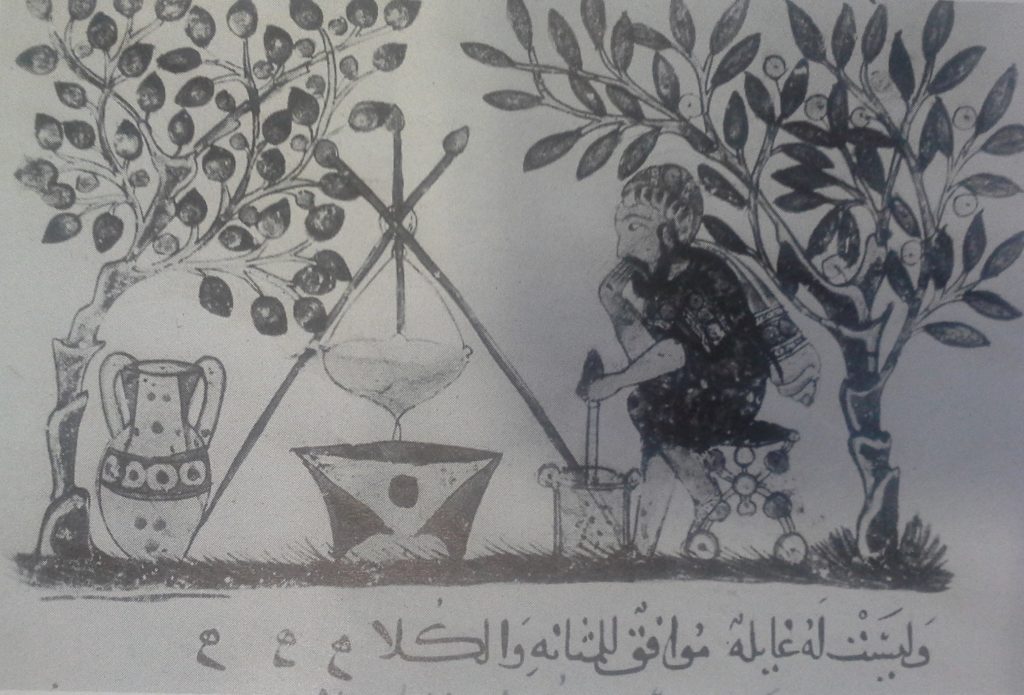
There were many learned Moslem mathematicians. Omar Khayyam was a famous Persian poet, but in his own times Omar Khayyam was more noted as a mathematician and astronomer than as a poet. Our term algebra comes from the title of a book on mathematics written by a scholar from Turkestan. Moslem scholars, moreover, learned how to work out solutions to new problems in geometry and trigonometry.
Arab astronomers revived the old Greek idea that the world is a revolving sphere. At their observatory in Baghdad, they checked the movements of heavenly bodies and recorded valuable astronomical information. The fact that Arabs carried on a thriving sea trade made them students of the science of navigation. They improved on an ancient Greek invention, the astrolabe. This was an instrument sailors used to find their position when out of sight of land and was the forerunner of the sextant used in navigation today. The Arabs also adopted a simple form of compass. Astronomers calculated the latitude and longitude of many places. This knowledge, added to what explorers and sailors had learned, helped the Arabs to draw maps of the parts of the world which they knew.
Some progress was made in physics and chemistry. Moslem scientists also made advances in such branches of science as physics and chemistry. An important topic in physics is the study of light. The Greeks believed that the human eye sends out light rays to the objects it sees. A famous Moslem scholar put forward the idea that light rays from the object strike the eye. This principle is the foundation of everything we now know about light.
Some progress was made in chemistry, as well. Arab scientists discovered how to make a number of new chemicals and drugs. They were especially interested, however, in alchemy. A major purpose of alchemy was to discover some means of turning common metals into gold. Although this effort was unsuccessful, the alchemists established certain principles of chemistry and introduced new methods of chemical research.
Medical studies progressed. Arab doctors translated the studies of Galen and other Greek writers on medical subjects. They also mastered the methods and knowledge of Persian and Indian physicians and became very skillful in discovering the causes of diseases and in treating them.
About the year 1000 a Moslem doctor, Avicenna, wrote a famous book called the Canon of Medicine. This encyclopedia of medical knowledge furnished valuable information about the medicines of that time. The Canon of Medicine was translated into Latin for doctors in western Europe and was in use among Moslem peoples until recently. A world-famous physician, Dr. William Osler, has said that this remarkable book served as “a medical bible for a longer period than any other work”. Another noted Moslem physician of Cordova in Spain wrote a book on surgery which was illustrated with drawings of surgical instruments. Translated into Hebrew, Spanish and Latin, this book is considered by some authorities as the starting point of surgery in western Europe.
Arab literature was not limited to science alone. Of all Arabic writings, the Koran was the greatest and most influential. History, too, interested the Arabs and there were 500 or more histories written by Moslem scholars. Moslems were also very fond of poetry. The following verses, translated into English by a British poet about a hundred years ago, will give an idea of the poetry of Omar Khayyam:
A Book of Verses underneath the Bough,
A jug of Wine, a Loaf of Bread and Thou Beside me singing in the Wilderness — Oh, Wilderness were Paradise enow [enough]!
The Moving Finger writes; and, having writ,
Moves on: nor all your Piety nor Wit
Shall lure it back to cancel half a Line,
Nor all your Tears wash out a Word of it.
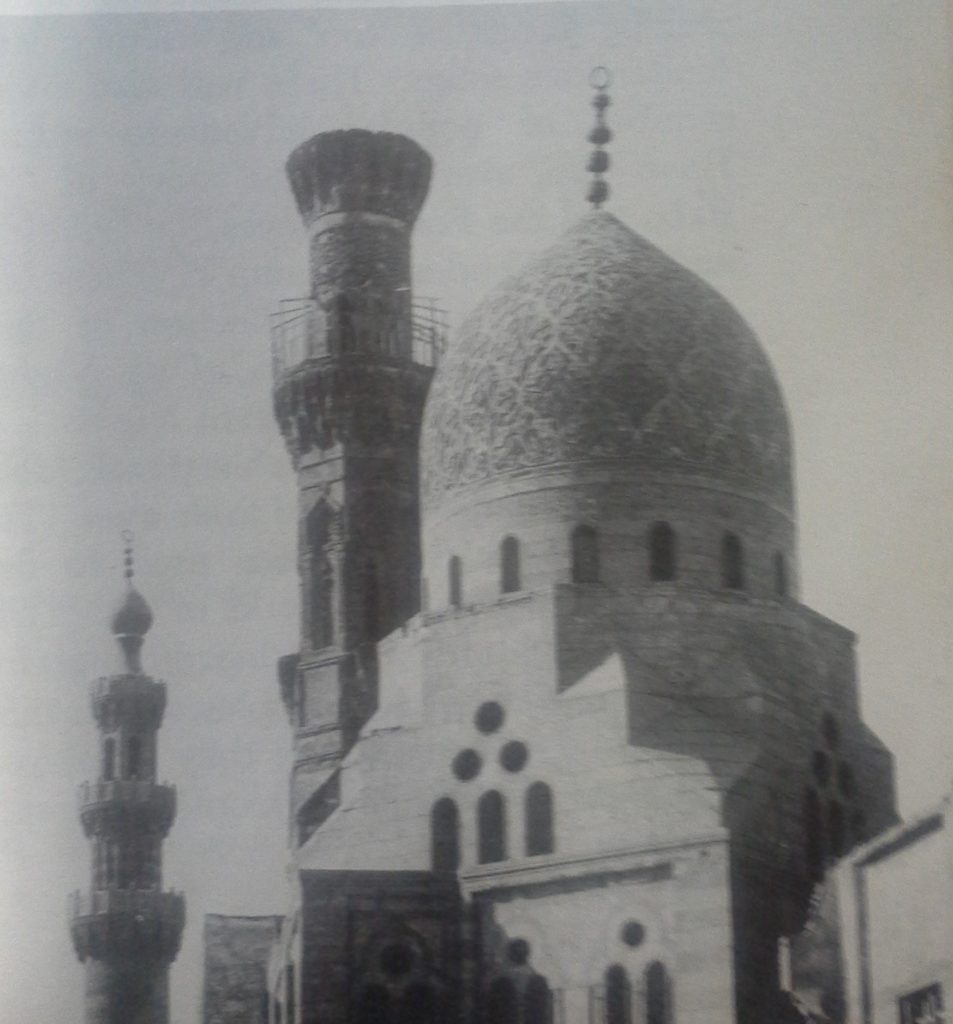
In Moslem countries religious ideas were often expressed in poetry. Even food recipes were sometimes written in verse.
Much of the literature described above was read and enjoyed only by educated people. But people who could not read had their literature too — in the form of songs and stories. There were the songs that weary men sang as their caravans crossed the lonesome deserts and the Arabs had other songs — hunting songs, stirring songs of war and victory and tender love songs. There was also a vast number of popular adventure stories. Have you ever read the story of “Ali Baba and the Forty Thieves,” or “Aladdin and His Wonderful Lamp”? These are only two of a large collection of tales called The Thousand and One Nights, better known as The Arabian Nights.
Moslems borrowed architectural ideas but introduced features of their own. The early Arabs had not been used to fine buildings or beautiful works of art. They soon came, however, to admire the architecture and art of the peoples whom they conquered. Furthermore, they employed craftsmen of conquered peoples to create things of beauty.
Although the Moslems built splendid palaces and public buildings, the most important structures in the Moslem world were places of worship, the mosques. In some cases, the Christian churches of conquered lands were made into mosques, but new mosques of great magnificence were numerous throughout the Moslem world. Each mosque had a large hall where worshipers could assemble to pray and to hear Sermons or readings from the Koran. Each mosque likewise had one or more slender towers, or minarets. Five times each day from the minarets, chanters summoned the faithful to face the holy City of Mecca and pray. There was also an enclosed court with a fountain where worshippers cleansed themselves before entering the mosque.
In their mosques and other public buildings, Arabs adopted older features of architecture such as the round dome, but they also introduced new features, such as the horseshoe-shaped arch.
Moslem works of art were famed for rich materials and intricate designs. The Moslems made wide use of decorations of glazed tile and ornamental inscriptions in Arabic lettering. Their buildings are famous, too, for lace-like patterns of straight and curved lines and floral designs carved in stone, known as arabesques. Their mosaics of coloured glass were similar to those created by Byzantine craftsmen.
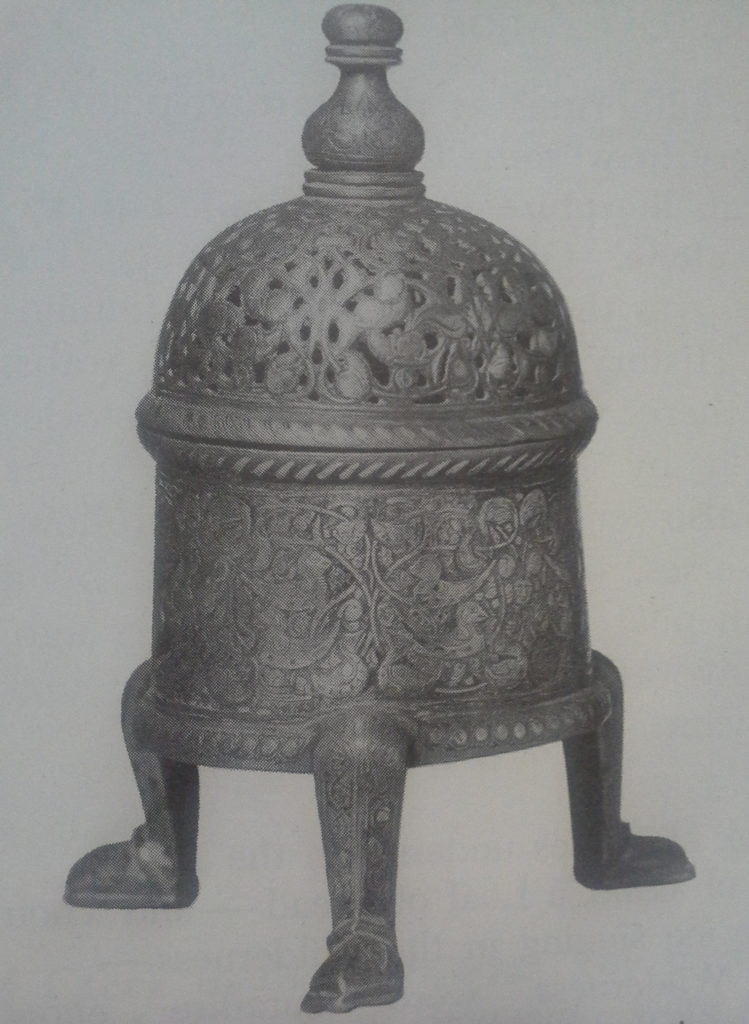
Since the followers of Islam were forbidden to paint or carve human or animal forms, Moslem sculptors and artists produced few great statues or paintings. Rather they expressed their love of beauty, colour and design in other ways. Carpet weaving, borrowed from Persia and Mesopotamia, became an art. Rugs were made of silk or wool and woven in beautiful colours and patterns. Today we can see examples of antique oriental rugs exhibited in museums.
Metalworkers produced articles which were beautiful in form and rich in decoration. There were copper, bronze, or brass objects, sometimes inlaid with gold and silver. The great hanging lamps used in mosques are outstanding examples of Moslem craftsmanship. Glass lamps, decorated with coloured enamel and painted pottery were very much in demand. Handwritten books or manuscripts were often illustrated with tiny paintings and ornamental lettering.
Moslem civilization exerted important influences in the world’s progress. In time, the civilization which flourished under the Arabs and spread throughout the Moslem world ceased to move forward. In the 1100’s there grew up among the Moslems a narrow religious viewpoint which insisted that scientific studies contradicted the teachings of the Koran. Without freedom for scholars to think and study, progress in science slowed down. The surge to power of the half-wild Turks from central Asia — first the Seljuk Turks and later the Ottoman Turks — helped to bring about a decline of civilization.
Nevertheless, early Moslem civilization had played an important role in the world’s progress. The time when it was at its height was the very period when progress in western Europe had declined following the fall of the Western Roman Empire. In Spain and Sicily, which were meeting grounds for Moslems and Christians, men from western Europe became familiar with the wisdom of Arab scholars. Moslem products and objects of art also trickled into western Europe. This trickle was to grow into a broad stream of trade during the Crusades.
Not only did Moslem peoples pass along the accomplishments of earlier peoples, particularly the Greeks and Romans, but they added their own contributions to the new civilization which western Europe was to build. Finally, Moslem civilization of more than 1000 years ago became the basis for the Moslem world of our time. Today some 450 million Moslems follow Mohammed’s teachings and are governed by the laws of Islam. Many of the Moslems of today speak and write Arabic and carry on the old Arab arts and crafts.

